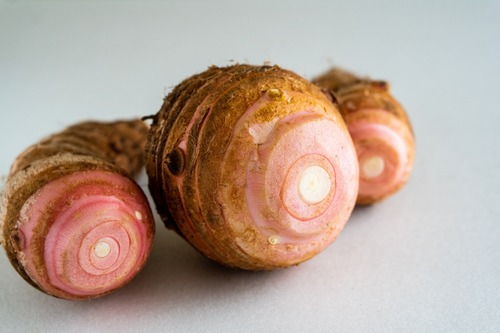
Shrimp taro root is a type of taro characterized by its unique shape and striped pattern that resembles a shrimp. The flesh is dense and sticky with a unique texture and rich flavor, making it one of the best tasting traditional vegetables in Kyoto. The typical Kyoto delicacy has been enjoyed by households since ancient times, and is often used in stews because it does not easily fall apart. It is mainly eaten at New Year's and other festive occasions, and is often made from autumn to winter when shrimp taro roots are sold in stores.
Shrimp taro root is not a variety of potato, but a product of a unique cultivation method. It is said that a court official who served the Shorenin-no-miya during the Anei period and who was entrusted with the cultivation of chrysanthemums was given the task of cultivating the potato seeds brought back from Nagasaki, and was able to produce large shrimp-shaped potatoes with stripes on the skin, which was eventually named "ebi-imo."
Later, through a series of ingenious ways of cooking the dish with "bodara," a dried codfish brought mainly from Hokkaido, the Kyoto taste of "imobo" was invented. It is said that the gelatinous material from the cod prevents the shrimp taro root from falling apart, while the scum from the shrimp taro root tenderizes the cod. Such a characteristic of Kyoto cuisine is known as "deaimon," in which ingredients from different parts of Japan with completely different characteristics are used to bring out the best in each other.
When you come to Kyoto, please enjoy imobo, a combination of Kyoto's taste and wisdom accumulated over the years. If you would like to make it at home, please prepare it in a traditional earthenware pot such as the ovenable and microwavable Matsuyama Tokojo's Yukihira Pot to stay warm in the cold winter. If you can't find shrimp taro root, you may use the usual taro instead.
Matsuyama Tokojo's Yukihira Pot
https://www.shokunin.com/en/matsuyama/
References
http://www.imobou.com/imobou
https://www.maff.go.jp/j/keikaku/syokubunka/
https://ja-kyoto.jp/kyoyasai/ebiimo.html